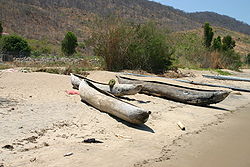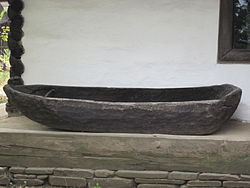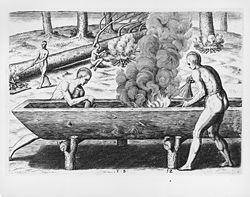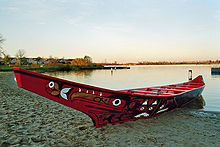- Dugout (boat)
-
A dugout or dugout canoe is a boat made from a hollowed tree trunk. Other names for this type of boat are logboat and monoxylon. Monoxylon (μονόξυλον) (pl: monoxyla) is Greek -- mono- (single) + ξύλον xylon (tree) -- and is mostly used in classic Greek texts. In Germany they are called einbaum ("one tree" in English)). Some, but not all, pirogues are also constructed in this manner.
Dugouts are the oldest boats archaeologists have found, dating back about eight thousand years[1]. This is probably because they are made of massive pieces of wood, which tend to preserve better than, e.g., bark canoes. Einbaum dug-out boat finds in Germany date back to the Stone Age. Along with bark canoe and hide kayak, dugout boats were also used by indigenous peoples of the Americas.
Contents
Construction
Construction of a dugout begins with the selection of a log of suitable dimensions. Sufficient wood needed to be removed to make the vessel relatively light in weight and buoyant, yet still strong enough to support the crew and cargo. Specific types of wood were often preferred based on their strength, durability, and density. The shape of the boat is then fashioned to minimize drag, with sharp ends at the bow and stern.
First the bark is removed from the exterior. Before the appearance of metal tools, dugouts were hollowed-out using controlled fires. The burnt wood was then removed using an adze. Another method using tools is to chop out parallel notches across the interior span of the wood, then split out and remove the wood from between the notches. Once hollowed out, the interior was dressed and smoothed out with a knife or adze.
For travel in the rougher waters of the ocean, dugouts can be fitted with outriggers. One or two smaller logs are mounted parallel to the main hull by long poles. In the case of two outriggers, one is mounted on either side of the hull.
Africa
The well-watered tropical rainforest and woodland regions of sub-Saharan Africa provide both the waterways and the trees for dugout canoes, which are commonplace from the Limpopo River basin in the south through East and Central Africa and across to West Africa. African Teak is the timber favoured for their construction, though this comprises a number of different species, and is in short supply in some areas. Dugouts are paddled across deep lakes and rivers or punted through channels in swamps (see makoro) or in shallow areas, and are used for transport, fishing and hunting, including, in the past, the very dangerous hunting of hippopotamus. Dugouts are called pirogues in Francophone areas of Africa.
Eastern Europe
De Administrando Imperio details how the Slavs built monoxyla that they sold to Vikings in Kiev.[2] These ships were then used against the Byzantine Empire during the Rus'–Byzantine Wars of the 9th and 10th centuries. They used dugouts to attack Constantinople and to withdraw into their lands with bewildering speed and mobility. Hence, the name of Δρομίται ("people on the run") applied to the Rus in some Byzantine sources. The monoxyla were often accompanied by larger galleys, that served as command and control centres. Each Slavic dugout could hold from 40 to 70 warriors.
The Cossacks of the Zaporozhian Host were also renowned for their artful use of dugouts, which issued from the Dnieper to raid the shores of the Black Sea in the 16th and 17th centuries. Using small, shallow-draft, and highly maneuverable galleys known as chaiky, they moved swiftly across the Black Sea. According to the Cossacks' own records, these vessels, carrying a 50 to 70 man crew, could reach the coast of Anatolia from the mouth of the Dnieper River in forty hours.
Northern Europe
Dugout boats have been found in Scandinavia and Germany. In German, the craft are known as einbaum (one-tree). These boats were used for fishing and transport on calmer bodies of water.[3] Dugouts require no metal parts or shipbuilding expertise, and were likely common amongst farming folk in Northern Europe until large trees suitable for making this type of watercraft became scarce. Length was limited to the size of trees in the old-growth forests -- up to 10 metres (33 ft) in length.[4] Later models increased freeboard (and seaworthiness) by lashing additional boards to the side of the boat. Eventually, the dugout portion was reduced to a solid keel, and the lashed boards on the sides became a Lapstrake hull.
In Northern Europe, the tradition of making dugout canoes survived into the 20.-21. century only in Estonia, where seasonal floods in Soomaa, a 390 km² wilderness area, make conventional means of transportation impossible. In recent decades a new surge of interest in making dugouts (Estonian haabjas) has revitalized the ancient tradition.[5]
North America
Dugout canoes were constructed throughout the Americas where suitable logs were available. The indigenous people of the Pacific Northwest are very skilled at crafting wood. Best known for totem poles up to 80 feet (24 m) tall, they also construct dugout canoes over 60 feet (18 m) long for everyday use and ceremonial purposes.[6]
In 1978, Geordie Tocher and two companions sailed a 3.5-short-ton (3.2 t), 40-foot (12 m) dugout canoe (the Orenda II), made of Douglas-fir, and based on Haida designs (but with sails), from Vancouver, Canada to Hawaiʻi to add credibility to stories that the Haida had travelled to Hawaiʻi in ancient times. Altogether they ventured some 4,500 miles (7,242 km) after two months at sea.[7][8]
The dugout canoes were made mostly of huge cedar logs in the state of Washington for the ocean travelers but for natives that lived on the smaller rivers used smaller cedar logs.
United Kingdom
 The Poole Logboat made from a single oak tree is over 2,000 years old. It is currently in the Poole Museum.
The Poole Logboat made from a single oak tree is over 2,000 years old. It is currently in the Poole Museum.
Two log boats were discovered in Newport, Shropshire and are now on display at Harper Adams University College Newport. The Iron Age residents of Great Britain were known to have used logboats for fishing and basic trade. In 1964, a logboat was uncovered in Poole Harbour, Dorset. The Poole Logboat dated to 300 BC was large enough to accommodate 18 people and was constructed from a giant Oak tree. It is currently located in the Poole Museum.
Pacific Islands
- See also Māori migration canoes, Waka
In the Pacific Islands, dugout canoes are very large, made from whole mature trees and fitted with outriggers for increased stability in the ocean, and were once used for long-distance travel. Such are the very large waka used by Māori who ventured to New Zealand many centuries ago. Such vessels carried 40 to 80 warriors in sheltered waters or smaller numbers thousands of miles across the Pacific ocean. In Hawaiʻi, waʻa (canoes) are traditionally manufactured from the trunk of the koa tree. They typically carry a crew of six: one steersman and five paddlers.
John F. Kennedy's PT-109
The Solomon Islanders have used and continue to use dugout canoes to travel between islands. In World War II these were used during the Japanese occupation - with their small visual and noise signatures these were among the smallest boats used by the Allied forces in World War II. After the sinking of PT-109, Biuki Gasa reached the shipwrecked John F. Kennedy by dugout.
See also
- Log canoe
- Traditional fishing boat
References
- ^ 1000 Inventions and Discoveries, by Roger Bridgman
- ^ Excerpt from the "De Administrando Imperio" with self-study questions.
- ^ [1] Viking era dugout boat found in lake
- ^ [2]
- ^ Haabjas - Estonian Dugout Canoe. Retrieved 5-2-2011.
- ^ [3] Pacific Northwest Coastal Indians website
- ^ Stall, Robert (5 March 1979). "A man, a tree and an ocean to cross". Maclean's: 4–6.
- ^ Peter SpSpeck, Peter (22 November 1978). "Orenda recalled". North Shore News: pp. 2 and 12.
External links
- Fundamental origins of ship types
- Ship replicas in the world
- For more information on Tocher's voyage
Types of sailing vessels and rigs - Barca-longa
- Barque
- Barquentine
- Bermuda rig
- Bermuda sloop
- Bilander
- Brig
- Brigantine
- Caravel
- Carrack
- Catamaran
- Catboat
- Clipper
- Dutch clipper
- Cog
- Corvette
- Cutter
- Dhow
- Dinghy
- East Indiaman
- Falkuša
- Felucca
- Fifie
- Fluyt
- Fore-and-aft rig
- Frigate
- Full rigged pinnace
- Full rigged ship
- Fusta
- Gaff rig
- Galeas
- Galleon
- Gunter rig
- Hermaphrodite brig
- Herring buss
- Hoy
- Jackass-barque
- Jangada
- Junk
- Ketch
- Koch
- Longship
- Lugger
- Man-of-war
- Mast aft rig
- Masula
- Mersey Flat
- Multihull
- Nao
- Nordland
- Norfolk punt
- Norfolk wherry
- Pausik
- Pilot cutter
- Pink
- Pinnace (ship's boat)
- Pocket cruiser
- Polacca
- Pram
- Proa
- Razee
- Sailing barge
- Sailing hydrofoil
- Scow
- Schooner
- Ship of the line
- Sixareen
- Sgoth
- Shitik
- Sloop
- Sloop-of-war
- Smack
- Snow
- Square rig
- Tall ship
- Thames sailing barge
- Trailer sailer
- Treasure ship
- Trimaran
- Uru
- Vinta
- Well smack
- Wherry
- Windjammer
- Windsurfer
- Xebec
- Yacht
- Yawl
- Yoal
About fishing vessels Commercial - Commercial fishing boats
- Trawlers
- Seiners
- Drifters
- Longliners
- Factory ships
- Fishery Protection Squadron
- Fishing fleet
- Research vessels
- Whalers
- Whaling ships
- British ships
- Japanese ships

Traditional - Traditional fishing boats
- Bawley
- Bokkura
- Caïque
- Cape Islander
- Chasse-marée
- Coble
- Coracle
- Couta
- Currach
- Dogger
- Dhoni
- Dugout
- Falkuša
- Felucca
- Fifie
- Friendship sloop
- Galway hooker
- Herring buss
- Jangada
- Jukung
- Kolae
- Lugger
- Luzzu
- Mackinaw
- Monterey clipper
- Nobby
- Pirogue
- Poveiro
- Reed boat
- Sampan
- Sgoth
- Shad boat
- Sixareen
- Smack
- Sneakbox
- Well smack
- Yawl
- Yoal
Dories Oyster boats Recreational Builders and designers List of resources about traditional arts and culture of Oceania Art ahu · Australia · Austronesia · Cook Islands · Hawaiʻi · kapa (Hawaiʻi) · lei (Hawaii) · magimagi · Māori · moai · New Zealand · nguzu nguzu · Oceania · Papua New Guinea · reimiro · tā moko · tapa ["masi" (Fiji), "ngatu" (Tonga), "siapo" (Sāmoa), " ʻuha" (Rotuma)] · tabua · ta'ovala · tattoo · tēfui · tivaivaiBroad culture Geo-specific, general Australia · Australian Aboriginal astronomy · Austronesia · Caroline Islands, -Pwo · Chatham Islands · Cook Islands · Easter Island · Fiji, -Lau Islands, -traditions and ceremonies · Guam · Hawaiʻi, -Lomilomi massage · Kiribati · French Polynesia's Marquesas Islands · Marshall Islands, -Stick charts of · Federated States of Micronesia · Nauru · New Caledonia · New Zealand · Niue · Norfolk Island · Palau · Papua New Guinea · Pitcairn Islands · Sāmoa · Solomon Islands · Tonga · Torres Strait Islands · Tuvalu · Vanuatu · Wallis and Futuna · Yap, -navigation, -Weriyeng navigation schoolCanoes Aboriginal Dugout · Alingano Maisu · Drua · Dugout (boat) · Hawaiʻiloa · Hōkūleʻa · Modern Hawaiian outrigger · Māori migration · Outrigger · Polynesian sailing · Proa · Waka,-List of · WalapDance Festivals Australia's Garma Festival · Hawaiʻi's Aloha Festivals, Merrie Monarch Festival, and World Invitational Hula Festival · Fiji · New Zealand's Pasifika Festival · The Pacific Community's Festival of Pacific Arts · Festivals in Papua New GuineaLanguages by areaLanguages of Oceania Sovereign states - Australia
- East Timor (Timor-Leste)
- Fiji
- Indonesia
- Kiribati
- Marshall Islands
- Federated States of Micronesia
- Nauru
- New Zealand
- Palau
- Papua New Guinea
- Samoa
- Solomon Islands
- Tonga
- Tuvalu
- Vanuatu
Dependencies and
other territories- American Samoa
- Christmas Island
- Cocos (Keeling) Islands
- Cook Islands
- Easter Island
- French Polynesia
- Guam
- Hawaii
- New Caledonia
- Niue
- Norfolk Island
- Northern Mariana Islands
- Pitcairn Islands
- Tokelau
- Wallis and Futuna
by categoryLiterature Literature of Oceania Sovereign states - Australia
- East Timor (Timor-Leste)
- Fiji
- Indonesia
- Kiribati
- Marshall Islands
- Federated States of Micronesia
- Nauru
- New Zealand
- Palau
- Papua New Guinea
- Samoa
- Solomon Islands
- Tonga
- Tuvalu
- Vanuatu
Dependencies and
other territories- American Samoa
- Christmas Island
- Cocos (Keeling) Islands
- Cook Islands
- Easter Island
- French Polynesia
- Guam
- Hawaii
- New Caledonia
- Niue
- Norfolk Island
- Northern Mariana Islands
- Pitcairn Islands
- Tokelau
- Wallis and Futuna
Music Austral Islands (French Polynesia) · Australia · Austronesia · Cook Islands · Easter Island · Fiji · Guam · Hawaiʻi · Kiribati · Lali · Māori · Melanesia · Northern Mariana Islands · Micronesia · Federated States of Micronesia · Nauru · New Caledonia · New Zealand · Niue · Palau · Papua New Guinea · Polynesia · Sāmoa · Slit drum · Solomon Islands · Tahiti · Tokelau · Tonga · Tuvalu · Vanuatu · Wallis and FutunaMythology Australian Aboriginal · Fijian · Māori · Melanesian · Menehune · Micronesian · Oceanian legendary creatures · Polynesian · Rapa Nui · VanuatuPeople Indigneous Australian · Austronesian · Chamorro · Chatham Islander (Moriori or Rekohu) · Fijian · Hawaiian (kānaka maoli) · Māori · Marshallese · Melanesian · Micronesian · Negrito · Norfolk Islander · Papuan · Polynesian · Indigenous Polynesian (Mā’ohi) · Rapanui · Rotuman · Samoan · Tahitian · Tongan · Torres Strait IslanderReligion Religion in Oceania Sovereign states Dependencies and
other territories- American Samoa
- Christmas Island
- Cocos (Keeling) Islands
- Cook Islands
- Easter Island
- French Polynesia
- Guam
- Hawaii
- New Caledonia
- Niue
- Norfolk Island
- Northern Mariana Islands
- Pitcairn Islands
- Tokelau
- Wallis and Futuna
Not included: Oceanian: cinema, (indigenous) currency, dress, folkore, cuisine. Also see Category:Oceanian culture. Categories:- Boat types
Wikimedia Foundation. 2010.








